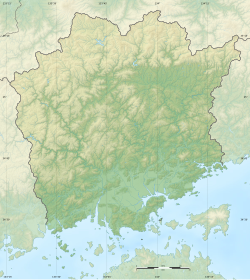Top Qs
Timeline
Chat
Perspective
Tsuyama Domain
Administrative division in western Japan during the Edo period (1600-1871) From Wikipedia, the free encyclopedia
Remove ads
Tsuyama Domain (津山藩, Tsuyama-han) was a feudal domain under the Tokugawa shogunate of Edo period Japan, in what is now northern Okayama Prefecture. It controlled most of Mimasaka Province and was centered around Tsuyama Castle. It was ruled in its early history by a branch of the Mori clan, and later by a branch of the Matsudaira clan. Tsuyama Domain was dissolved in the abolition of the han system in 1871 and is now part of Okayama Prefecture.[1][2][3]


Remove ads
History
Summarize
Perspective
In 1600, after the Battle of Sekigahara, Mimasaka Province was ruled by Kobayakawa Hideaki, the daimyō of Okayama Domain. However, his domain was abolished due to attainder on his death without heir in 1602. In 1603, the Tokugawa shogunate appointed Mori Tadamasa, the son of Mori Yoshinari of Kawanakajima Domain in Shinano Province and the younger brother of Oda Nobunaga's page Mori Ranmaru, to the newly created Tsuyama Domain with a kokudaka of 186,000 koku. He changed the name of the area, which was originally called Tsuruyama (鶴山) to "Tsuyama", began construction of Tsuyama Castle in 1604 and completed the layout of his castle town by 1616. In 1697, his 5th generation successor Mori Sugutoshi went insane in Ise Province on his way to Edo to fulfill his sankin kōtai duties. The "madness" may have been an excuse, as Sugutoshi had been in charge of constructing dog kennels outside Edo as part of Shogun Tokugawa Tsunayoshi's highly unpopular and ridiculed law against cruelty to animal and Sugutoshi reportedly fell into a rage on hearing that a ronin had broken into the kennel, slaughtering many dogs, which had resulted in the shogunate ordering the execution of a number of his retainers for negligence.
The domain was reduced to 100,000 koku, and transferred to a branch of the Echizen-Matsudaira clan whose ancestor was Yūki Hideyasu. In 1721, the second daimyō, Matsudaira Asagoro died at the age of 11 without heir. The shogunate agreed to allow a younger son of the daimyō of Shirakawa Nitta Domain to be posthumously adopted to secure the succession, but the kokudaka of the domain was halved to 50,000 koku. The prestige and also the ability of the domain to support its retainers was thus severely restricted, and the domain thereafter suffered from political and economic instability and frequent peasant uprisings. In 1765, the 5th daimyō, Matsudaira Yasuchika, opened a han school, the Kakuzankan (鶴山館), which lasted into the early Meiji period. The domain managed to restore its status to 100,000 koku when the 7th daimyō, Matsudaira Naritaka, adopted the 14th son of Shogun Tokugawa Ienari as his heir.Matsudaira Naritami was very active in the affairs of the Tokugawa family after 1868. Naritami was also known as Matsudaira Kakudō.[4]
In the Bakumatsu period, the domain produced a number of doctors and rangaku scholars, including diplomat and legal scholar Tsuda Mamichi and future Prime Minister Hiranuma Kiichiro. In 1871, the domain became Tsuyama Prefecture due to the abolition of the han system. It was later incorporated into Okayama Prefecture via Hōjō Prefecture.
Remove ads
Holdings at the end of the Edo period
As with most domains in the han system, Tsuyama Domain consisted of several discontinuous territories calculated to provide the assigned kokudaka, based on periodic cadastral surveys and projected agricultural yields, g.[5][6]
- Mimasaka Province
- 22 villages in Higashinanjō District
- 3 villages in Aida District
- 7 villages in Yoshino District
- 45 villages in Shōnan District
- 10 villages in Katsuhoku District
- 26 villages in Nishisaijō District
- 25 villages in Nishihōjō District
- 25 villages in Tohokujō District
- 10 villages in Kumehōjō District
- 32 villages in Oba District
- Sanuki Province
- 6 villages in Shōzu District
- 3 villages in Aida District
In addition to the above, Tsuyama was in charge of administration of tenryō territories in Mimasaka: 7 villages in Tohokujō District, 27 villages in Oba District, and 32 villages in Saijō District.
Remove ads
List of daimyō
Summarize
Perspective
Simplified genealogy (Matsudaira)
 Tokugawa Ieyasu, 1st Tokugawa shōgun (1543–1616; r. 1603–1605)
Tokugawa Ieyasu, 1st Tokugawa shōgun (1543–1616; r. 1603–1605)
- Yūki (Matsudaira) Hideyasu, 1st daimyō of Fukui (1574–1607)
- Tokugawa Yorinobu, 1st daimyō of Kishū (1602–1671)
- Tokugawa Mitsusada, 2nd daimyō of Kishū (1627–1705)
 Tokugawa Yoshimune, 8th Tokugawa shōgun (1684–1751; 5th Lord of Kishū: 1705–1716; 8th Tokugawa shōgun: 1716–1745)
Tokugawa Yoshimune, 8th Tokugawa shōgun (1684–1751; 5th Lord of Kishū: 1705–1716; 8th Tokugawa shōgun: 1716–1745)
- Tokugawa Munetada, 1st Hitotsubashi-Tokugawa family head (1721–1765)
- Tokugawa Harusada, 2nd Hitotsubashi-Tokugawa family head (1751–1827)
-
 Tokugawa Ienari, 11th Tokugawa shōgun (1773–1841; r. 1786–1837)
Tokugawa Ienari, 11th Tokugawa shōgun (1773–1841; r. 1786–1837)
-
- Tokugawa Harusada, 2nd Hitotsubashi-Tokugawa family head (1751–1827)
- Tokugawa Munetada, 1st Hitotsubashi-Tokugawa family head (1721–1765)
- Tokugawa Mitsusada, 2nd daimyō of Kishū (1627–1705)
Remove ads
See also
Wikimedia Commons has media related to Tsuyama Domain.
References
Wikiwand - on
Seamless Wikipedia browsing. On steroids.
Remove ads




